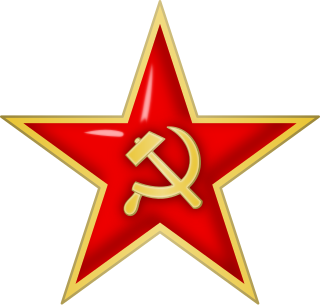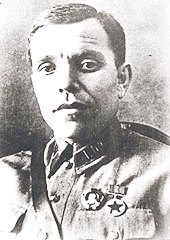A tank corps was a type of Soviet armoured formation used during World War II.
A mechanised corps was a Soviet armoured formation used prior to the beginning of World War II and reintroduced during the war, in 1942.
The 18th Army of the Soviet Union's Red Army was formed on 21 June 1941 on the basis of HQ Kharkov Military District and armies of the Kiev Special Military District.

The Soviet Airborne Forces or VDV was a separate troops branch of the Soviet Armed Forces. First formed before the Second World War, the force undertook two significant airborne operations and a number of smaller jumps during the war and for many years after 1945 was the largest airborne force in the world. The force was split after the dissolution of the Soviet Union, with the core becoming the Russian Airborne Forces, losing divisions to Belarus and Ukraine.
The 75th Guards Rifle Division was a Red Army infantry division during World War II and afterwards, which later became the 75th Guards Tank Division and was finally disbanded in the 1990s.

The 20th Guards Motor Rifle Division is a formation of the Russian Ground Forces, originally formed within the Soviet Red Army as the 3rd Mechanised Corps. The division was reformed in 2021 from the former 20th Guards Motor Rifle Brigade.
The Separate Coastal Army, also translated to English as Independent Coastal Army, was an army-level unit in the Red Army that fought in World War II. It was established on July 18, 1941, by the order of the Southern Front from the forces of 9th Army’s Coastal Group and was stood up on July 20, 1941.
The 12th Guards Uman Orders of Lenin Red Banner and Suvorov Tank Division was a tank division of the Soviet Ground Forces. It drew its history from the World War II 16th Tank Corps. It was redesignated successively as 12th Guards Tank Corps (1943) and 12th Guards Tank Division (1946).
The 47th Army was a field army of the Red Army during World War II, active from 1941 to 1946.
The 372nd Rifle Red Banner Novgorod Division was a division of the Red Army during the Second World War.
The 7th Guards Cavalry Corps of the Soviet Union's Red Army was a cavalry corps active during the Second World War. It was formed from the 8th Cavalry Corps in February 1943.

The 5th Shock Army was a Red Army field army of World War II. The army was formed on 9 December 1942 by redesignating the 10th Reserve Army. The army was formed two times prior to this with neither formation lasting more than a month before being redesignated.
The 207th Rifle Division began its combat path under unusual circumstances. It was partly formed for the first time as a standard Red Army rifle division in the spring of 1941, before the German invasion, but was never completed. A second formation began in April 1942 and was completed on June 1, after which it was sent to the Stalingrad Front. Heavily depleted in counterattacks against the north flank of German Sixth Army, by November the survivors were reassigned and the division disbanded. The 207th was formed for a third time in June 1943, and fought its way through the central part of the Soviet-German front, ending the war in the heart of Berlin in the battle for the Reichstag. The division saw postwar service in the Group of Soviet Forces in Germany.
The 37th Guards Rifle Division was an infantry division of the Red Army which fought during World War II.

Konstantin Ivanovich Provalov was a Soviet Army Colonel general and Hero of the Soviet Union. Provalov was awarded the title Hero of the Soviet Union and the Order of Lenin for his leadership of a regiment in the Battle of Lake Khasan. After Operation Barbarossa, Provalov became the commander of the 383rd Rifle Division. He led the division during the Battle of the Caucasus. In 1943, he became commander of the 16th Rifle Corps and fought in the Kerch–Eltigen Operation and Crimean Offensive. In May 1944, Provalov transferred to command the 113th Rifle Corps and led it during the Vitebsk–Orsha Offensive. In July he became commander of 36th Rifle Corps, which fought in the Minsk Offensive, the Gumbinnen Operation, the Battle of Königsberg and the Prague Offensive. Postwar, Probalov led the 3rd Guards Rifle Corps, 9th Guards Rifle Corps, 13th Rifle Corps and 31st Special Rifle Corps. In 1958, he became commander of the 4th Army. From 1962 to 1968 he led the Southern Group of Forces.

Alexey Grigoryevich Rodin was a Soviet Army colonel general and Hero of the Soviet Union.
The 397th Rifle Division was partially raised in 1941 as an infantry division of the Red Army but this formation was disbanded after about five weeks. A new formation began on January 14, 1942 in the Volga Military District and it remained in that role through the rest of the Great Patriotic War. It first went to the front in March, briefly assigned to the 3rd Shock Army before it was moved to the 1st Shock Army in Northwestern Front. It spent nearly a year in the dismal fighting around the Demyansk salient; during January, 1943 two of its rifle regiments were encircled and nearly destroyed during an unsuccessful offensive before escaping. During the last stages of the Demyansk battles it was in the 53rd Army. After rebuilding it moved to Bryansk Front in the new 63rd Army and took part in the summer offensive that liberated Smolensk. Late in the year it was briefly assigned to the Belorussian Front and then to the 1st Ukrainian Front; while serving under this command it won a battle honor. In late February, 1944 it became part of the 47th Army in 2nd Belorussian Front. Prior to the summer offensive it was moved again, now to the 61st Army, where it would remain for the duration. During the later stages of Operation Bagration it was decorated with the Order of the Red Banner and in the fall during the campaign in the Baltic states it would also receive the Order of Kutuzov. By the end of the year the 61st Army was assigned to 1st Belorussian Front and the 397th fought through Poland and eastern Germany during the winter and spring of 1945, eventually taking part in the offensive on Berlin. Its soldiers had by then compiled a distinguished record of service, but despite this the division was disbanded in July.
The 227th Rifle Division was an infantry division of the Red Army, originally formed in the months just before the start of the German invasion, based on the shtat of September 13, 1939. It arrived at the front in July and was assigned to 26th Army along the Dniepr, but was fortunate to escape that Army's encirclement in September. During the next several months, the division fought as part of 40th Army in the Kursk region, operating toward Prokhorovka and Oboyan during the winter counteroffensive. It made noteworthy gains during the May 1942 offensive north of Kharkiv but these went for naught when the southern wing of the offensive collapsed. When the main German summer offensive began in late June, the division's 21st Army was directly in the path of the German 6th Army and the depleted 227th was soon destroyed on the open steppes.




